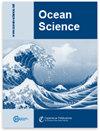Multi-model analysis of the Adriatic dense-water dynamics
IF 3.3
3区 地球科学
Q2 METEOROLOGY & ATMOSPHERIC SCIENCES
引用次数: 1
Abstract
Abstract. This study aims to enhance our understanding of the bora-driven dense-water dynamics in the Adriatic Sea using different state-of-the-art modelling approaches during the 2014–2015 period. Practically, we analyse and compare the results of the following four different simulations: the latest reanalysis product for the Mediterranean Sea, a recently evaluated fine-resolution atmosphere–ocean Adriatic Sea climate model, and a long-time-running Adriatic Sea atmosphere–ocean forecast model used in both hindcast and data assimilation (with 4 d cycles) modes. As a first step, we evaluate the resolved physics in each simulation by focusing on the performance of the models. Then, we derive the general conditions in the ocean and the atmosphere during the investigated period. Finally, we analyse in detail the numerical reproduction of the dense-water dynamics as seen by the four simulations. The likely prerequisites for proper modelling of the ocean circulation in the Adriatic basin, including a kilometre-scale atmosphere–ocean approach, non-hydrostatic atmospheric models, fine vertical resolutions in both atmosphere and ocean, and the location and forcing of the open boundary conditions, are thus discussed in the context of the different simulations. In conclusion, a 31-year-long run of the fine-resolution Adriatic Sea climate model is found to be able to outperform most aspects of the reanalysis product, the short-term hindcast, and the data-assimilated simulation in reproducing the dense-water dynamics in the Adriatic Sea.亚得里亚海稠密水动力学的多模型分析
摘要本研究旨在利用2014-2015年期间不同的最先进的建模方法,提高我们对亚得里亚海bora驱动的致密水动力学的理解。实际上,我们分析和比较了以下四种不同的模拟结果:最新的地中海再分析产品,最近评估的精细分辨率大气-海洋-亚得里亚海气候模式,以及用于后发和数据同化(4 d周期)模式的长期运行的亚得里亚海-大气-海洋预报模式。作为第一步,我们通过关注模型的性能来评估每个模拟中的解析物理。然后,我们推导出调查期间海洋和大气的一般情况。最后,我们详细分析了四种模拟所看到的稠密水动力学的数值再现。因此,在不同的模拟背景下,讨论了亚得里亚海盆地海洋环流适当模拟的可能先决条件,包括公里尺度的大气-海洋方法、非流体静力大气模式、大气和海洋的精细垂直分辨率以及开放边界条件的位置和强迫。总之,经过31年运行的亚得里亚海精细分辨率气候模式在再现亚得里亚海稠密水动力学方面优于分析产品、短期后发和数据同化模拟的大多数方面。
本文章由计算机程序翻译,如有差异,请以英文原文为准。
求助全文
约1分钟内获得全文
求助全文
来源期刊

Ocean Science
地学-海洋学
CiteScore
5.90
自引率
6.20%
发文量
78
审稿时长
6-12 weeks
期刊介绍:
Ocean Science (OS) is a not-for-profit international open-access scientific journal dedicated to the publication and discussion of research articles, short communications, and review papers on all aspects of ocean science: experimental, theoretical, and laboratory. The primary objective is to publish a very high-quality scientific journal with free Internet-based access for researchers and other interested people throughout the world.
Electronic submission of articles is used to keep publication costs to a minimum. The costs will be covered by a moderate per-page charge paid by the authors. The peer-review process also makes use of the Internet. It includes an 8-week online discussion period with the original submitted manuscript and all comments. If accepted, the final revised paper will be published online.
Ocean Science covers the following fields: ocean physics (i.e. ocean structure, circulation, tides, and internal waves); ocean chemistry; biological oceanography; air–sea interactions; ocean models – physical, chemical, biological, and biochemical; coastal and shelf edge processes; paleooceanography.
 求助内容:
求助内容: 应助结果提醒方式:
应助结果提醒方式:


